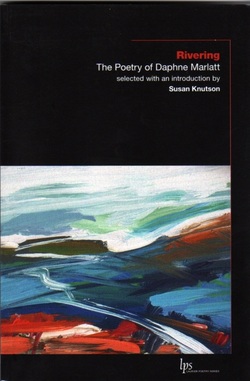
Daphne Marlatt’s Rivering is a recent addition to WLUP’s Laurier Poetry Series, a series of 90- page volumes of Canadian selected poems, each with an introduction and afterword, that series editor Neil Besner writes here that he hopes will do for Canadian poetry what the New Canadian Library “series has done ... for Canadian fiction” (ix). Like those of the New Canadian Library, the WLUP volumes appear to have been designed for academic sale – Besner describes using 10 of them himself in teaching a fourth-year poetry course, though at $16.99 a pop the ten would have put a serious dent in some of his students’ budgets. For the poets, the recognition implied by being included in the series may be more useful than any increase in readership. In Marlatt’s case, the selection does not seem to compete in any significant way with her previous books.
Marlatt is not an easy poet to select from, for an anthology or a ‘selected.’ She has usually published coherent books of interconnected poems, or ‘book-length poems’ as critics often say (as if 'book' were a stable measure), rather than collections, books that have often been held together in part by narrative, image, epistemological or linguistic threads – Frames of a Story (1968), Rings (1971), Steveston (1974), How Hug a Stone (1983), Touch to My Tongue (1984). In her afterword Marlatt writes of having been attracted to the poetry resources of prose – that what she has wanted to achieve in poetry seemed “more possible in the relatively open space of prose, but a prose that could meet poetry in its attentiveness to language” (63). The sentences of her novels have often seemed little different structurally from those of her poetry. I was once
Editor Knutson tends to deal with this aspect of Marlatt’s writing by selecting highlights – “Combe Martin ... ” from How Hug a Stone, and “Slave of the Canneries” from Steveston. But these, as also the two excerpts from The Given, are dotted with references, rhythms, and images that only habitual readers of Marlatt will be able to recognize connect resonantly with absent parts of the books from which they have been taken. It was perhaps for this reason that Marlatt’s first selected poems, published by Talonbooks in 1980, was punningly titled Net Work.
Most selecteds give a roughly representative sampling of what the poet has written. This one gives only a glimpse – mostly a sense of the page by page texture of the writing. And it’s the best any editor could have done. My friend John Bentley Mays used to say of art that “when it’s all up front, there ain’t nothin’ out back.” Well, wonderfully for any new reader, there’s a lot more out back of this book.
FD
 RSS Feed
RSS Feed